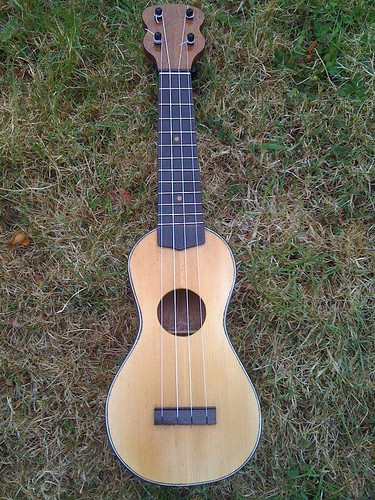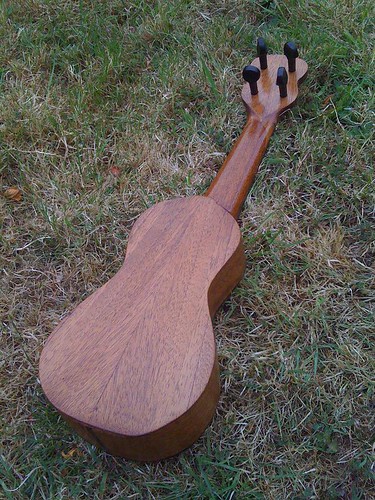1900 Hamlin Mason sound board
-
Celeste Hall
- Posts: 23
- Joined: Sun Jan 08, 2012 12:24 am
- Location: Maryland
1900 Hamlin Mason sound board
My dad has the sound board from a 1900 Hamlin Mason grand piano in the shop. It was cracked, so replaced in a major rebuild of the instrument 2-3 years ago. Neither of us have plans or inspirations for it, and we both would rather see it used to make something that sings again rather then trash it. Looking for brain storm ideas, or even if it has value that someone else would be interested in.
-
Clay Schaeffer
- Posts: 1674
- Joined: Fri Jan 06, 2012 12:04 pm
Re: 1900 Hamlin Mason sound board
Hi Celeste,
Most piano soundboards have so many bridges and blocks glued to them that it is hard to get pieces of any size from them. They are often less than perfectly quartersawn. I have gotten some nicely aged bracewood from upright piano soundboards which is certainly better than trashing them. A grand piano may have better possibilities for reuse. Do you have a picture of it?
Most piano soundboards have so many bridges and blocks glued to them that it is hard to get pieces of any size from them. They are often less than perfectly quartersawn. I have gotten some nicely aged bracewood from upright piano soundboards which is certainly better than trashing them. A grand piano may have better possibilities for reuse. Do you have a picture of it?
-
Nicholas Blanton
- Posts: 66
- Joined: Wed Jan 11, 2012 9:52 am
- Location: Shepherdstown, WV, USA
- Contact:
Re: 1900 Hamlin Mason sound board
Upright piano soundboards I have recycled for bracing and for fretted dulcimer tops, but nothing more. A grand piano soundboard has fewer holes than an upright piano soundboard; I have never gotten a grand piano soundboard to recycle, but it should be better source of wood therefore than an upright. And like Clay says, the quality of piano soundboard wood is quite variable- but I would expect a Mason & Hamlin to be better than average.
I did find the best way to get rid of the braces was to cut kerfs across them - though not all the way through them- and then use a chisel and mallet to knock out the pieces between the kerfs. Then either plane the last bits off the soundboard or cut it up and feed it into the planer. Removing the bridge is similar, but you have to pull all the pins first, and if the bridge is laminated it can require more kerfs, more mallet-whacking, and more sweat.
I did find the best way to get rid of the braces was to cut kerfs across them - though not all the way through them- and then use a chisel and mallet to knock out the pieces between the kerfs. Then either plane the last bits off the soundboard or cut it up and feed it into the planer. Removing the bridge is similar, but you have to pull all the pins first, and if the bridge is laminated it can require more kerfs, more mallet-whacking, and more sweat.
-
Celeste Hall
- Posts: 23
- Joined: Sun Jan 08, 2012 12:24 am
- Location: Maryland
Re: 1900 Hamlin Mason sound board
Yeah, I know about the uprights, we have burned a few of them, back in the days when my brother was a piano tech, kind of makes you feel like Napoleon in Moscow. I would expect it to be above average as well, given the quality of the instrument it was removed from.
I don't currently have a pic of it, I grabbed my phone when Dad asked me about it, only to find the battery to dead to take a picture, once again, defeated by modern technology. I'll try to get some pictures this weekend
I don't currently have a pic of it, I grabbed my phone when Dad asked me about it, only to find the battery to dead to take a picture, once again, defeated by modern technology. I'll try to get some pictures this weekend
-
Chris Reed
- Posts: 168
- Joined: Thu Feb 02, 2012 6:26 pm
Re: 1900 Hamlin Mason sound board
This uke's top came from a grand piano soundboard (I think a 1920s Grenson). Sounds pretty good, but there are barely visible join lines as the soundboard strips are about 2.5 inches wide.


The body is from an old mahogany shelf and the neck from a wardrobe carcass, so the only materials I had to buy were the rosewood for fretboard and bridge, the fret wire and the tuning pegs.
The uneven colour of the top is my camera, not the instrument itself!


The body is from an old mahogany shelf and the neck from a wardrobe carcass, so the only materials I had to buy were the rosewood for fretboard and bridge, the fret wire and the tuning pegs.
The uneven colour of the top is my camera, not the instrument itself!
-
Clay Schaeffer
- Posts: 1674
- Joined: Fri Jan 06, 2012 12:04 pm
Re: 1900 Hamlin Mason sound board
Cool ukulele! Tonewood is where you find it.
